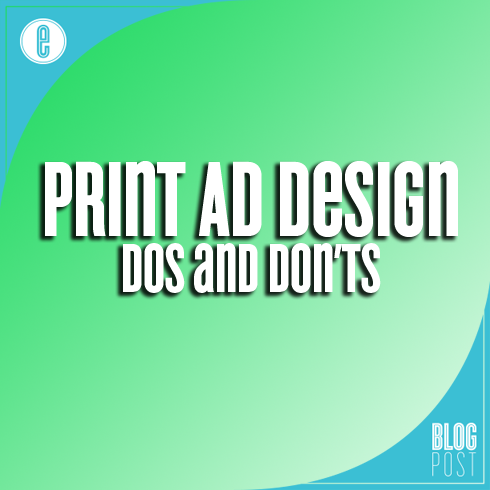
Though online promotion has grown in popularity, print advertising is still a great way to reach your target audience and boost brand recognition. To reap the benefits, however, you will have to put emphasis on the right kind of print ad design.
Print ad design is a highly specific niche guided by a set of rules and principles. Understanding which strategies deliver the best results and which ones miss the mark will help you make the most of the opportunity.
The DOs of Print Ad Design
What is your message? Does the print ad design convey this message clearly? The focal elements should highlight the theme of the ad. Use a hierarchy of information to guide the audience’s attention towards the most important statement you are trying to make.
Successful print ad design is bold and clear. Easy to read fonts and high-quality graphics should work together. Minimalism is the best approach. A few prominent graphics will do a much better job than having numerous elements scattered throughout the page.
Remember one of print ad design’s most basic principles – white space is your friend. There is no need to have the entire page covered. A few meaningful elements will be sufficient to impress and to get your message across.
Put emphasis on your brand identity. Your logo, slogan, and contact information need to be displayed clearly. Make it easy for prospects to contact you after viewing the ad.
All of the slogans and promo phrases should be kept short. Something catchy and simple is easy to remember. Some of the most brilliant slogans are several words long. Make the design and the copywriting work together for the creation of a harmonious print ad.
The DON’Ts of Print Ad Design
Some mistakes are very common and they could be detrimental. The use of graphical elements for the sake of having those on the page is one of the biggest mistakes. Print ad design should be functional. If you find it difficult to justify the presence of an element or a font on the page, you should probably make that element disappear.
Avoid long, puzzling, and difficult to understand messages. Something abstract could be fun but make sure that the audience gets the idea quickly. Trying too hard to make the message original will usually result in obscurity. Nobody will spend more than a couple of seconds trying to decipher your message.
Contrast makes print ads come to life. Refrain from using a monotone color palette or tones that are very similar to each other. Use contrast to highlight the most important parts of the message and to create some visual appeal.
Finally, don’t use a single design to say many things to your audience. Each print ad should have a particular, highly specific purpose. Trying to accomplish too much through a single promo piece will simply result in confusion.
The best print ad design is relevant, bold, and minimalist. Such advertising materials are much more difficult to create than cluttered, overly-ornate designs. Take your time, refine your idea, and work with a professional team for the creation of the most impressive print ad designs.
If you’re looking for more information to assist your business during this time, head over to our Marketing Resources menu to gain access to our Lead Generation Calculator, Website Analyzer, and to Download our Free 2020 Social Media Guide!
-FINAL(01-00)-White&Blue-01.svg)




